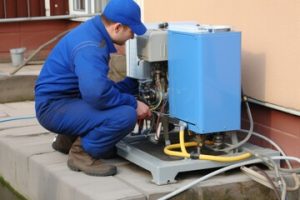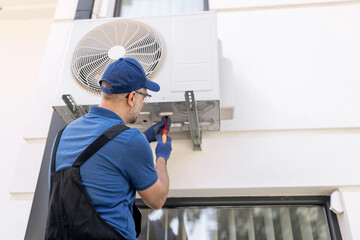HVAC systems provide heating, cooling, ventilation and indoor air quality control. Products include furnaces, air conditioners, heat pumps, ductwork, thermostat controls and smart home features.

Selecting the right HVAC system depends on a building’s size, occupancy, climate zone and energy goals. Professionals conduct load calculations and energy modeling to recommend the most efficient equipment. Contact MASON HEATING AND COOLING for professional help.
HVAC systems are responsible for heating and cooling homes, and they also provide ventilation. They are a key part of our indoor comfort, keeping us warm in winter and cool in summer, and they also help keep air fresh and free from harmful pollutants.
While the acronym may be familiar to many, the specifics of how an HVAC system works may be less clear. This is because the term often refers to a combination of elements, from a furnace or heat pump to an air conditioning unit and the ductwork that runs between them.
When it comes to heating, HVAC systems typically use natural gas or electricity to fuel boilers or furnaces. The hot gases produced by these units then pass through a heat exchanger, which raises the temperature and sends it to the ductwork so that warm air is circulated throughout the home or building.
In order to properly cool the air, an HVAC system must first dehumidify it. The resulting cooled air can then be passed through filters to remove pollutants and to ensure that it is the right temperature for human occupants. It can then be distributed through the same ductwork and vented outdoors in order to keep indoor spaces comfortable.
Ventilation is the final function of an HVAC system, and it involves circulating air throughout a space to prevent stale or stagnant air from building up and creating health issues. These systems typically use fans to move air through ducts, and they are frequently integrated with carbon monoxide detectors and smoke alarms.
An air conditioning unit completes an HVAC system, and it is designed to cool and dehumidify air by passing it over refrigerant coils. The vapor in the refrigerant absorbs the heat, which causes it to turn into a liquid. The vapor is then carried to the compressor where it is pressurized, and when it returns to the condenser coil it releases the heat into the air as cool, conditioned air.
Those who are interested in learning more about the technology behind HVAC systems can pursue career training through vocational schools and community colleges. Certificate programs (6-12 months) can give students a basic understanding of the field, while associate degree programs (2 years) can provide more in-depth coverage of topics, including system design and energy efficiency.
Cooling
We all appreciate a refreshing blast of air conditioning on a sweltering summer day, and warm cozy fires in winter. All of this indoor comfort is made possible by Heating, Ventilation and Air Conditioning systems (HVAC). These comprehensive solutions are the cornerstone of modern indoor living. They ensure that a home or business is comfortable year-round by regulating temperature, filtering pollution and reducing moisture.
HVAC systems come in several configurations to suit a variety of spaces and climate conditions. The most common type is a split system with separate units for heating and cooling. This setup consists of a furnace or heat pump for heating and an air conditioner for cooling. Some systems also utilize ductwork to distribute air throughout a building. Hybrid systems combine an air conditioner with a gas or electric furnace for maximum efficiency in varied temperatures.
Air conditioning relies on the same basic principles as human sweat, which cools the body by evaporative cooling. In a modern HVAC system, the evaporator coil holds chilled liquid refrigerant that draws ambient air over it and speeds up evaporation. Once the vapor reaches a higher pressure than the air around it, the refrigerant absorbs that heat and moves it to the condenser unit outside. The evaporator coil is a key component of this closed-loop system.
The cooled air is then distributed through the house by a network of ducts, while the thermostat provides the control. HVAC technicians are trained to assess a space and select the best equipment to meet its needs. They must have a broad range of skills to perform repair and maintenance work, including plumbing, electrical, metalwork, brazing and carpentry. They must also be familiar with local codes, regulations and licensing requirements.
If you’re intrigued by the science behind HVAC equipment and enjoy working with your hands, a career in this field may be for you. Accredited HVAC training programs offer a combination of theoretical knowledge and practical skills, including simulated labs, real-world experience with actual equipment and internships or apprenticeships. Options range from 6-month certificates to 2-year associate degrees, so you can choose the program that suits your needs and career goals.
Ventilation
The “V” in HVAC may not get as much attention as the heating and cooling aspects of an HVAC system, but it’s still a crucial component. Ventilation, which ensures that indoor air is regularly exchanged with outdoor air to keep it fresh and clean, prevents pollutants, moisture, and gases like carbon monoxide from building up in the home or business. It also helps to reduce heating and cooling bills.
Ventilation can be natural or mechanical. Natural ventilation involves opening windows and doors to allow fresh outdoor air to enter. This is effective on mild days but can become a challenge during extreme heat or cold. It can also force your HVAC system to work harder to maintain the temperature you want and can make it difficult to control indoor humidity.
Another type of ventilation involves using localized fans, such as exhaust fans in bathrooms and kitchens, to remove odors and excess moisture from the air. These fans can be used independently or in conjunction with your HVAC system, and can significantly reduce the amount of odors and moisture in the air throughout your home.
A more advanced form of ventilation is a whole-house ventilator, which uses fans to force stale indoor air out of the building and push fresh air into it. This type of ventilation can be controlled with a thermostat or automated by a timer, and can help to improve energy efficiency.
The HVAC industry offers a wide variety of educational and career opportunities, from 6-month certificate programs to 2-year associate degrees. Many training programs focus on preparing students to work with real HVAC equipment in simulated environments, and often include internships or apprenticeships that provide valuable hands-on experience. In addition, most states require licensed HVAC technicians to complete continuing education courses to keep their licenses current and to stay abreast of changes in the industry. These ongoing educational opportunities are essential for ensuring that technicians are properly trained and qualified to service HVAC systems. In addition, obtaining an HVAC certification such as NATE (North American Technician Excellence) can demonstrate your commitment to the profession.
Maintenance
The simplest way to keep HVAC equipment running at peak efficiency is to perform routine maintenance on the unit and its components. Regular check-ups and tune-ups ensure that the heat pump, furnace, or air conditioning system is functioning correctly throughout the year, resulting in lower energy bills.
While many DIY maintenance tasks can be performed by property occupants, some require professional HVAC maintenance. A professional can identify potential issues with the system, provide repairs or replacements, and make recommendations to keep the HVAC equipment in good condition.
Performing routine HVAC preventive maintenance is the best way to avoid costly repair bills and prolong the lifespan of the system. It’s also the best way to increase the comfort of building occupants.
The first step in a comprehensive HVAC maintenance plan is to identify the most common areas of concern. These include electrical problems, dirty coils, ductwork leaks, and more. During a regular inspection, these problems can be corrected before they cause more serious damage.
Regularly cleaning the HVAC unit is another critical aspect of maintenance. This helps to remove mould and dust, which improves the air quality for occupants. This is especially important for occupants who suffer from allergies or breathing ailments such as asthma.
A good HVAC maintenance plan should include two precision system tune-ups per year. This allows technicians to catch minor problems before they turn into expensive repair bills. The plan should also cover a wide range of maintenance activities, such as checking the air filter, inspecting the thermostat and its controls, and examining ductwork for leaks.
During an HVAC maintenance visit, the technician should also check the evaporator and condenser coils for dirt and debris. These can restrict air flow and cause the HVAC unit to work harder to cool or warm the home. If the coils are dirty, they can be cleaned using a garden hose with a soft brush attachment or a wet/dry vacuum.
It’s also a good idea to check the drip pan and condensate drain line for visible blockages. A blocked pan or line can lead to overflow and mold growth, which is hazardous for the unit. The drip pan should be emptied and the line cleaned using a wet/dry vacuum or a sandblaster.
